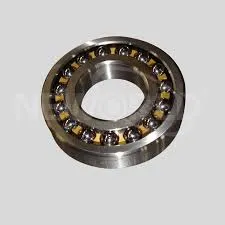
Nov . 27, 2024 11:45 Back to list
Understanding Thrust and Radial Bearings in Mechanical Engineering Applications and Design
Understanding Thrust and Radial Bearings A Comprehensive Overview
Bearings are essential components in various mechanical systems, serving to reduce friction between moving parts, support loads, and ensure smooth operation. Among the different types of bearings, thrust and radial bearings play crucial roles in diverse applications, from automotive engines to heavy machinery. This article aims to explore the functions, designs, and applications of thrust and radial bearings, highlighting their significance in mechanical engineering.
What are Bearings?
Bearings are mechanical devices that enable relative motion between two parts, typically rotating or moving. They are designed to accommodate loads while minimizing friction. The primary types of bearings include radial bearings, which primarily support loads perpendicular to the shaft, and thrust bearings, which are designed to handle axial loads, or loads that act along the axis of the shaft.
Radial Bearings
Radial bearings are primarily used to support the radial loads acting on rotating shafts. These loads are perpendicular to the shaft's axis, and radial bearings are capable of accommodating both static and dynamic loads. There are various designs of radial bearings, including ball bearings, roller bearings, and sleeve bearings.
1. Ball Bearings Utilizing spherical balls between the inner and outer races, ball bearings reduce friction and handle moderate loads. They are widely used in applications where speed and efficiency are critical.
2. Roller Bearings Designed with cylindrical rollers, roller bearings can withstand greater loads than ball bearings. They are particularly useful in heavy machinery and automotive applications where high radial loads are present.
3. Sleeve Bearings Also known as plain bearings, sleeve bearings provide a low-friction surface for the shaft to rotate against. They are simple in design and effective in low-speed applications with relatively low loads.
thrust and radial bearing

Thrust Bearings
Thrust bearings, on the other hand, are specifically designed to accommodate axial loads—that is, forces directed along the shaft axis. They are crucial in applications where rotating elements must resist axial movements, such as in gear systems and turbine engines. Thrust bearings can be classified into two main types thrust ball bearings and thrust roller bearings.
1. Thrust Ball Bearings These bearings utilize balls positioned between a shaft washer and a housing washer to facilitate axial load support. They are effective in applications where the load is consistently axial, such as in electric motors and gearboxes.
2. Thrust Roller Bearings Comprising cylindrical rollers, these bearings are designed for higher load capacities compared to thrust ball bearings. They are ideal for heavy-duty applications where significant axial loads need to be managed.
Applications of Thrust and Radial Bearings
The applications of thrust and radial bearings are vast and varied. In automotive engineering, radial bearings are commonly used in wheel assemblies, engines, and transmissions, where they help maintain efficient rotation and reduce wear. Thrust bearings are critical in applications such as sailboat propeller shafts, where they support heavy axial loads.
In industrial machinery, thrust and radial bearings are essential components in conveyor systems, pumps, and fans. They facilitate smooth operation, ensuring that machinery remains efficient and reliable over time.
Conclusion
In summary, thrust and radial bearings are integral elements in numerous mechanical systems. By understanding their designs and functions, engineers can select the appropriate type of bearing for specific applications, ensuring optimal performance, longevity, and efficiency. As technology continues to evolve, the development of advanced bearing materials and designs may further enhance the capabilities and applications of thrust and radial bearings in modern engineering. Whether in vehicles, industrial equipment, or household appliances, these bearings play an indispensable role in facilitating movement and reducing friction.
Latest news
-
Premium Deep Groove Ball Bearings | High Speed & Reliability
NewsAug.29,2025
-
Durable Scaffolding Clamps - Secure & Reliable Tube Connectors
NewsAug.28,2025
-
Common Failures in Thrust Ball Bearings and Solutions
NewsAug.22,2025
-
How Tapered Roller Bearings Can Take Shock Loads
NewsAug.22,2025
-
Angular Bearings in High-Precision Spindles
NewsAug.22,2025
-
The Impact of Misalignment on Cylindrical Roller Bearing Performance
NewsAug.22,2025
